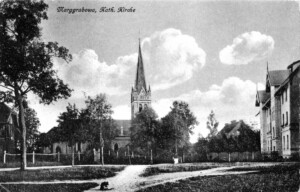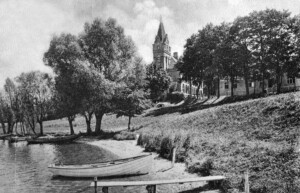Read in another language:
Siejnik (formerly Elisenhöhe) is a rural farm, now a suburb of Olecko, located on the right side of the Olecko-Luk road. An avenue of linden trees planted almost 15 years ago leads to it. Currently, a new settlement has formed around the manor. The estate belonged to Gottfried Zimmermann (1770-1858) and his third wife Elise Zimmermann (1788-1874). Both of them were the owners of the Lenz Hotel, which was established near the main square of the city, and other buildings in the city. Elise Zimmermann has established herself in the history of Marggrabowa forever. Her friendship with the Prussian ruler Frederick Wilhelm IV of Hohenzollern actually contributed to this to a large extent. Between 1838 and 1856, many letters were sent between Marggrabowa and Berlin by the town’s resident and the king. Her face is immortalized in H. Friedrich’s painting from 1853, which depicts the ruler’s arrival in Marggrabowa in 1845. Frederick Wilhelm IV, sitting in an open carriage, is greeted by a large crowd of residents in the flower-festooned main square of the city. On the right side, at one of the brick houses, you can see a woman in a dark dress and hat – the owner of the Elisenhöhe estate. Many anecdotes and stories have been created about Elise Zimmermann, and she was given the nickname “Madamchen”, which means “Lady” in German. Die-hard city history enthusiasts associate it with Arthur Zimmermann (born in 1864 in Marggrabowa – died in 1940 in Berlin), who became famous for adventures completely uncharacteristic of people occupying serious state positions. He, as the foreign minister of the German Empire, sent a telegram to the imperial embassy in Mexico in January 1917. The provocative content of the telegram led the hitherto neutral United States to enter World War I.
In 1853, these lands were given the name Elisenhöhe, which was not associated with the name of the owner, but with the name of Elisabeth von Preussen, the wife of Friedrich Wilhelm IV. The area of the estate was slightly less than 300 hectares, and in the 20th century at the beginning, it increased to 330. The following main activities were carried out on the farm: a brewery, a milking cow farm, and over time and with the introduction of changes by other owners, there were also 46 horse farms, even a farm of about 250 oxen and a farm of 50 pigs. Over time, the farm became a model business of agriculture, horticulture and crop production. Many of the best breeding animals, certified grain and fruit tree seedlings have been delivered. The credit for the development of the farm goes to other owners or tenants. Elise Zimmermann was succeeded by Carl Schielke, then the lands were bought from the Dresden bank by Ernst Pappendieck, whose inheritance later went to his daughter Frida Fähser. Her husband, Richard Fähser, turned the farm into an experimental business. Established and developed chicken farm (up to 6,000 and 11,000 units per year, respectively). He built hectares of greenhouses, for example, for tomatoes. Established apple and apricot orchards. Vegetables, fruits, poultry were sold to Úsruči (German: Insterburg) and Königsberg (German: Königsberg), some fruits – even to the Rhineland. The business soon became exemplary and largely mechanized. It had its patron of science, who was given big awards for farm animals. Girls’ school students used to do professional practice here. During both world wars, prisoners of war and forced laborers worked on the farm.
In January 1945, the Soviet army entered the town abandoned by the inhabitants. In June, Olecko was taken over by the Polish administration. The rulers quickly realized the economic and scientific potential of these lands. Elisenhöhe was renamed Siejnik and handed over to the Peasants’ Self-Help Union, from which the farm was briefly taken over by the National Rural Development Institute in Pulavai in 1948. The property carousel has been spinning for a long time. One by one, the lands were managed by the farm department, i.e. The Central Institute of Agriculture, later the Institute of Cultivation, Fertilization and Soil Science in Pulavai, followed by the Presidium of the National Council of Białystok Voivodeship, and from 1951 the Institute of Pomology in Skernevichi. In short, the Siejnik farm was supposed to expand agricultural culture in the region and provide farmers with seeds, seedlings, animals, and the inhabitants of Olecko with fruits and vegetables. Another 50-hectare garden “Elżbietki” was established for this purpose. Now the manor together with the outbuildings and part of the old area belong to private owners who have established a guest house and a restaurant there.
A built (or rebuilt) mansion is a large one-story building with a gable roof and a living attic. An alley of trees leads to the representative facade of the garden, diversified by the rhizolite at the axis of the building, finished with an elliptical tympanum. On the ground floor, the rhizolite forms a large veranda with a terrace instead of a roof, which can also be accessed from the attic. The facade from the side of the yard with the farm entrance has a practical function. Two one-story outbuildings stand at its side axes. The yard is surrounded by well-maintained, renovated outbuildings, and on the garden side of the manor is a picturesque park with old trees and ponds.



